Article
A Body in Motion:
The Afterlives of the Tomb of Henry Howard, Earl of Northampton
Résumé
L’impressionnant monument érigé à la mémoire d’Henry Howard, comte de Northampton, dans l’église St-Mary de Castro au château de Douvres vers 1614-1616, traduisait le fait qu’il avait réussi à revitaliser le nom et la fortune de la famille Howard. Mais négligence et accidents non seulement ont amoindri cette fière affirmation, mais ils ont également contraint à déménager cette tombe au Trinity Hospital de Greenwich. Cet essai examine les incidents qui ont motivé ce déménagement et plus tard le remaniement du monument, ce qui nous fournit une intéressante étude de cas des effets du temps et des circonstances sur un objet apparemment stable.
Abstract
The impressive monument erected to Henry Howard, Earl of Northampton in the church of St. Mary de Castro in Dover Castle ca. 1614-1616 epitomized his success in reviving the Howard family name and fortune. But neglect and accident not only reduced his proud statement to a lesser form, but also necessitated its move from its original site to Trinity Hospital in Greenwich. This essay examines the incidents that prompted the moving and later reworking of the monument, which provide an interesting case study of the effects of time and circumstance upon a seemingly stable object.
1 In the chapel at Trinity Hospital in Greenwich, the kneeling effigy of Henry Howard, Earl of Northampton (1540-1614), the Hospital’s founder, gazes out over the chancel from his perch on a marble monument (Fig. 1). The monument’s quiet serenity belies its protean past, as the present structure not only bears little resemblance to the one originally designed and erected for the Earl by his executors, but also began its life in the chapel of St. Mary in Castro in Dover Castle as directed by the Earl in his will. The first version of Northampton’s monument, which was completed and installed around 1616, was taken down in the late 17th century, moved approximately seventy miles to Trinity Hospital in Greenwich and reconstructed, then taken down again in the early 19th century and never restored to its original form. That form is now only known to us through a variety of sources, including several decorative remnants which remain at Trinity Hospital; two 17th century depictions of it, produced when it was still at its original site in Dover Castle; and a description of it by a correspondent of Horace Walpole’s after it had been rebuilt but was still in its original form at Trinity Hospital, one of the Earl’s three charitable foundations. The fate of Northampton’s grand memorial is both an interesting case study of the mobility that a supposedly permanent object may acquire through time—due to changing modes or the accidents of fate—and a curious echo of the effects reformation and iconoclasm had on other Howard family tombs, some of which are currently being investigated.
2 Perhaps the ultimate fate of his tomb would not have surprised Northampton. From a young age, he was well acquainted with the radical changes that could occur in a seemingly stable life, as he was caught up in the shifts of fortune that moved the dynamic and volatile Howard family back and forth between defeat and triumph multiple times in the 15th and 16th centuries. Northampton first suffered the loss of the status and lifestyle belonging to the son of a future Duke of Norfolk in 1547 at the age of six, with his father’s execution and his grandfather’s imprisonment and disgrace. Even the family’s return to favour in 1553 under Queen Mary I only restored him to the dignity and portion of a younger son, which provided him with little in the way of income or lands. Later, with Queen Elizabeth’s financial support, he took degrees at Cambridge and Oxford but remained essentially dependent on his brother, Thomas, 4th Duke of Norfolk, as well as on what he could earn as a university lecturer (Peck 1982: 8-10); and the distinction of being the most well-educated nobleman of his time, and the only one to teach at university in the 16th and early 17th centuries, was likely less a source of pride than a reminder of the family misfortunes.
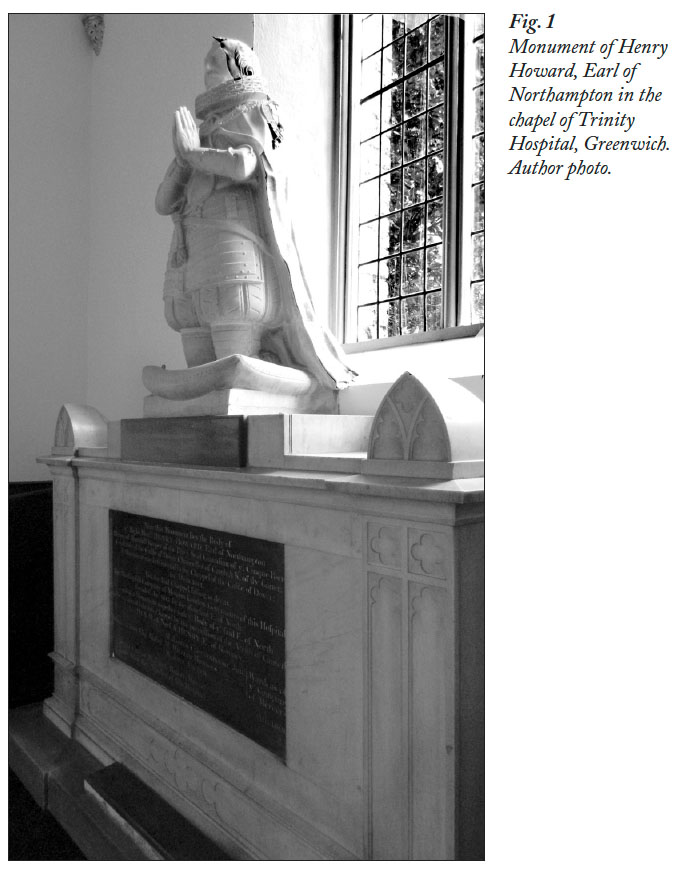 Display large image of Figure 1
Display large image of Figure 13 With the execution in 1572 of his brother, the 4th Duke of Norfolk—due to that noble- man’s involvement in a conspiracy to marry him to Mary Queen of Scots, remove Elizabeth I from the throne, and restore Catholicism to England—Northampton returned to a tenuous position, subsisting, according to Linda Levy Peck’s book on the Earl, mainly on the charity of his sister, Catherine, Lady Berkeley (Peck 1982: 10). Denied access to Elizabeth I during much of her reign, due to his brother’s fall and his own suspected involvement in Mary Stuart’s affairs, he gradually restored himself to her good graces and, finally, under James I, gained not only unfettered royal favour but also generous reward, due to his diligent participation in the confederacy between the Scottish king, Robert Devereux, Earl of Essex, and the Cecils to ensure a smooth transition for James to the Crown of England.
4 James’s accession marked the rapid elevation of Northampton, who, within a year of the new king’s succession, was appointed a member of Privy Council, given the offices of constable of Dover Castle and Lord Warden of the Cinque Ports, and elevated to baron of Marnhull and Earl of Northampton. As Peck has charted, his rise in favour and political power, including the additional honours of Keeper of the Privy Seal and Knight of the Order of the Garter, were matched by an equally swift rise in fortune; by the time he died in 1614, he was worth as much as £80,000, held a substantial estate encompassing lands in various counties, and was possessed of an impressive inventory of jewels, plate, furnishings, and art (Peck 1982: 64; Shirley 1869: 347-74). Additionally, he had brought renewed glory to the Howard name, marked visually by such noble edifices as Northampton House, his elaborate residence on the Strand, and the lodge in the royal park at Greenwich, of which he was granted the keepership in 1605 and refurbished at his own expense (Green 1857: 197). Comments by one observer of the size and splendour of the retinue that accompanied him on his final journey from Greenwich to Northampton House, where he died on June 16, 1614, indicate that at the end of his life he finally lived in the state becoming the scion of a great noble house (McClure 1939, 1: 539). Additionally, he had raised the memory of his father, Henry Howard, earl of Surrey, from shameful obscurity to dignified eminence through a richly decorated monument, which was constructed in the parish church of St. Michael at Framlingham, Suffolk, a seat of the Dukes of Norfolk for several centuries. His own monument, which was constructed shortly after Northampton’s death to serve as his permanent statement of fame at Dover Castle, was even grander.
5 But such glories fade in their turn. Northampton died unmarried and childless, leaving no one to carry on his title, which became extinct until its revival four years later as a new creation for the Compton family (Fryde et al. 1986: 474). Northampton House, which he left to his nephew, became first Suffolk House, then Northumberland House, when his great- grandniece, Lady Elizabeth Howard, married Algernon Percy, 10th Earl of Northumberland in 1642, and the house was transferred to Northumberland’s ownership as part of the marriage settlements. The Greenwich residence returned to the royal estate.
6 The most enduring of the material works Northampton established were the three charit- able hospitals he founded at Greenwich, at Castle Rising in Norfolk, and at Clun in Shropshire, still in use as housing for pensioners, and the tomb he erected to his parents, which remains in its ori- ginal site in St. Michael’s in Framlingham. That Surrey’s tomb has enjoyed a more stable afterlife than his son’s is one of fate’s ironies. Surrey, tried and attainted for treason at the end of Henry VIII’s reign, was buried unceremoniously in All Hallows by the Tower, where his body remained for nearly seventy years, at which time it was removed to Framlingham and finally installed in a tomb worthy of a son of the Norfolk duchy and one who was, increasingly, one of England’s most revered poets.
7 In choosing to be memorialized in the Dover Castle church, perhaps Northampton believed he was selecting a more stable site for his mausoleum than had previously been his family’s experience. In the year of his birth, 1540, Thetford Priory in Norfolk, which served as the dynastic mausoleum of the Dukes of Norfolk, was dissolved as a religious house, and his grandfather, Thomas, 3rd Duke of Norfolk, was faced with the task of re-establishing a family burial place. Uncertainty over the process may have prompted Northampton’s great-grandmother, Agnes Tilney, second wife and widow of the 2nd Duke, the hero of Flodden Field, to plan for her own tomb to be raised in the Howard Chapel built by the 2nd Duke himself at St. Mary’s, Lambeth where she was buried in 1545 (Colvin and Stone 1965: 162). Richard Marks speculates that she actually built her tomb in the 1530s, arguing that a post-dissolution monument would surely have included both her image and that of her husband, for whom a new monument was also made at Lambeth after Thetford was dissolved (Marks 1984: 257). The existing images of the two tombs indicate they were separate monu- ments, and both now exist only in images; the church suffered damage in the Commonwealth period, was extensively rebuilt in 1851, and again suffered damage during the Second World War; by 1951, the only remaining marker of the Howard family at Lambeth was a brass of Lady Katherine Howard, wife of Lord William Howard, “on the east wall of the organ chamber ... not in its original position,” and Roberts and Godfrey’s Survey of London says only that “many monuments and tablets were destroyed in 1851 and a number have been resited since” (1951: 104-17). In 1972, the crumbling church was deconsecrated, though saved from demolition, and rebuilt into the Museum of Garden History. Once again the Howard tombs were the victims of the de-consecration of a church, albeit more than four centuries after their deaths.
8 Perhaps there was not sufficient space at Lambeth for Northampton’s grand tomb or possibly the location held no personal attraction for him; in 1613 he wrote, “In this place I wolde be gladde with the ks grateouse favor to give up my last gaspe and laye my boanes,” referring to the royal lodge at Greenwich, his home during part of his childhood, and a place where he had made considerable improvements during his keepership (SPO 14/75, f.70 ). But a tug of war in 1613 with Queen Anne over keepership of the park and his fears of being displaced by her may have resembled too closely his grandfather’s attempt to save Thetford Priory from dissolution in 1540 in order to maintain it as the Howard mausoleum, an effort that had ultimately proved fruitless.
9 In this light, the Dover church may have appeared a much more stable option; Edward Hasted in his The History and Topographical Survey of the County of Kent recounted the belief that a church stood there from the 2nd century, and was used for both Christian and pagan rituals, depending on the local beliefs, until finally it was re-consecrated to the Virgin Mary after 597 by St. Augustine (Hasted 1800, 9: 478). John Lyon in his History of the Town and Port of Dover asserted that the church was probably built “by some of the first masons which arrived from the continent, after Saint Augustine” (1813-1814: 35). A more recent brief volume dates it rather to the 10th or 11th centuries (Brown 1979: 45). Nevertheless, in Northampton’s lifetime, St. Mary’s had been a Christian church for at least five hundred years, surviving the reformation with just a reduction in chaplains from three to one (Hasted 1800, 9: 479), and in the protected shelter of the Dover Castle earthworks, and as the church for the garrison, its future must have seemed assured. Additionally, burial at Dover Castle would serve to permanently connect Northampton with one of his most important offices, that of Warden of the Cinque Ports.
10 Within the Dover church, Northampton’s tomb was originally set up “on the right-hand side of the south chapel” (Hasted 1800, 9: 479). It was a grand and elaborately decorated structure, commissioned from the rising sculptor Nicholas Stone and his former master Isaac James, and incorporating what Nigel Llewellyn counts as the basic elements of the post-reformation monument; figure sculpture, architecture and ornament, text and heraldry (Llewellyn 1991: 115). The contract between the two sculptors and John Griffith, Northampton’s secretary and an executor of his will, offers a detailed description of its elements as well as precise measurements for its foundation and structure (Esdaile 1935: 222-24). It was to be made of white marble and touchstone, except for the foundation, which was to be of “hard stone of Kent,” and its dimen- sions were to be “from the grounde uppwards fourteene feete and one half foote and tenne feet in length belowe and seaven feet aboue, and in breadth at the ground below sixfeet & viii inches and in breadth aboue three feet and viii inches” (Esdaile 1935: 222). The elements were to be eight pillars of white marble; a coffin of touchstone set on two white marble pedestals on a “ledger” of touchstone; under that “ledger” six tables of touchstone, three on each side, and “cased in white Marble”; at each end, a “Coate of Armes wth supporters and Helmett & Crest Manteling and Garters”; and statues of the four Cardinal Virtues, one at each corner. The whole structure was to be topped by an entablature with the Earl’s kneeling effigy on top, in armour and garter robes with collar and George and with “a little boy,” or putto, seated on each corner holding escutcheons of arms (Edsaile 1935: 223). In size, format and decoration, it would serve as a formidable addition to Howard memorialization, and a marker of Northampton’s own importance. As a representative monument of the early 17th century, it was smartly up to date, with its clas- sicized figures and heraldic display, and it was also among the largest and most expensive of the commissions for which costs are known, that Stone secured during his career. Llewellyn states that in the post-reformation period, monuments used height to measure importance; certainly Northampton’s bore flattering comparison with other tombs of the great and good (Llewllyn 1991: 106).
11 Northampton’s efficient and hardworking secretary and primary executor, John Griffith, was both the chief negotiator and overseer of the project. Griffith, who served as Northampton’s private secretary from 1606, is designated as the signatory of the contract on behalf of the execu- tors (Esdaile 1935: 222; Thrush and Ferris 2010, 4: 479) and in Stone’s notebooks the sculptor comments that he “Agreid with Mr. Grefen for to mak a Tombe for my Lord of Northamton and to set it up in Dover Castell” (Spiers 1919: 38).
12 Until his own death in 1632, Griffith was busily occupied with Northampton’s estate and the demanding task of settling its terms satisfactorily, which included arranging annuities for persons specifically hired to take care of both the Earl’s tomb at Dover and that of his parents at Framlingham, no doubt seen as further insurance against damage and neglect. These annuities were to be paid once a year to the keepers by the Wardens of Trinity Hospital in Greenwich and receipts in the records of the Mercer’s company attest at least intermittently to their payment. On November 20, 1626 one William Eldred received payment from Abraham Nottingham, Warden of Trinity Hospital, of 40 shillings for one year’s fee owed at the feast of All Saints “for keeping of the said Earles [sic] tomb erected in the Castle church of Dover” and a further 5 shil- lings 10 pence for glazier’s work done in the aisle where the tomb was located (MCA 1/125/23). Similar payments on November 28, 1626, were made by Nottingham to St. Michael’s church in Framlingham of 26 shillings and 8 pence “for one whole years Annuity due at the feast of All Saints last past towards the maintenance of the Isle of the said Churche were the tombe of the Earle & Countesse of Surrey standeth” and of 13 shillings 4 pence “for one whole years Annuity due at the feast of All Saintes last past for keepinge the tombe erected in the said church for the Earle and Countesse of Surrey” (MCA 1/125/22).
13 Such receipts can be found at dates scattered throughout the 17th century, and show that the keepers were receiving funds both for “Keeping of Dust and Soil from off the said Tomb” (MCA 1/125/166, f. 114r), as well as “towards the repayre of that part or ysle of the Churche that the sayd Tomme is erected” (MCA 1/125/166, f. 81r). Indeed, in 1632, Eldred, still keeper of the tomb at Dover, was given money to defray his additional expenses for having repairs done in the chapel, including money for buying almost five metres of glass for an oval window at the foot; and, as he wrote, for mending and leading “divers places in the newe window where my lords armes standeth”; for “mending the shield that hangs over the Tombe with my lords armes being blown downe and broken”; “for mending and soldring the leads over the sayd Chappell”; and for “a mason to mortar the sayd Glass windows” (MCA 1/125/166, f. 124r).
14 Such elaborate works taking place within two decades of the tomb’s erection hints at the increasingly parlous state of the church and the need for constant upkeep of the monument and its surroundings. In fact, in a letter in the Calendar of State Papers for 1620 from Eldred to one Mr. Nicholas,1 asking him to prompt Griffith about payment of his yearly stipend for caring for the tomb—which he claimed not to have received for five years—he also mentions: “one of the great beames in the churche is vary lyke to fall this winter yf itt be not spedely repayred ... and yf itt should fall will doe great hurt” (SPO 14/117, f.40). There are notations in the 1623 receipts for the Surrey tomb in Framlingham of “new fittings and a lock for the Grate about ye tombe” (NLW Carreglwyd Papers, 398, Ser I), but overall there are fewer mentions of repairs for the Framlingham tomb than for the Dover tomb and such relative silence suggests that centuries of active use and neglect were making the Dover church an increasingly difficult site in which to maintain the tomb. John Puckle, Vicar of St. Mary in Castro in the 19th century, asserted in his book The Church and Fortress of Dover Castle that the reign of either Elizabeth I or James I was probably the last time modifications or improvements were made to the church; after that it was left to simply moulder away, though services may have been conducted there until the end of the 17th century (Puckle 1864: 126-27).
15 Howard Colvin’s The History of the King’s Works indicates that by the 16th century repairs to the castle were generally undertaken only in anticipation of a royal visit, often when it was used as a staging post for those coming from or going to France (Colvin 1975, 3: 243). Most of these repairs were for the royal lodgings or the fortifications, but in 1555-1557 during a major reconstruction program, the church received some attention as it was on the verge of collapse due to neglect (Colvin 1975, 3: 244). From Elizabeth I’s reign there is little evidence of work at the Castle beyond that required to keep it from “falling into ruin” (Colvin 1975, 3: 246). Samuel Percy Hammond Statham in his book The history of the castle, town, and port of Dover, published in 1899, wrote, “a considerable amount of damage must have been done to the internal decorations during the Commonwealth, and the decay of the building may be said to have begun at that period” (Statham 1899: 240). Hasted’s Survey of the County of Kent contains a sad litany of the fate of various tombs and monuments in the Dover church, such as the disappearance and destruction of stone tombs and the theft of brass effigies, and remarks on the stones that remained which showed only a shallow indent, which once contained a brass effigy (Hasted 1800, 9: 479-80). If Northampton had hoped that Dover would prove a more lasting mausoleum than some of his family’s other sites, he would have been sadly disappointed, but as a royal lodging and fortification at a key site in the defence of the southern coast of England, the expectation that the crown would maintain the building was not unreasonable.
16 The issue of keeping Northampton’s tomb in a fit state, and the problems inherent in the increasingly neglected Dover church, came to a crisis in 1691. In September of that year, a flurry of activity and some mild finger-pointing began over the dilapidated condition of the church and damage to the tomb, which was described in a letter dated June 27 from a Mr. Debinck in Dover to Edmund Harvey, then Warden of Trinity Hospital at Greenwich. Debinck wrote to Harvey that the church was in a “miserable condition” with broken windows and damage to the walls and roof, and he wrote that unless they could somehow block off the chapel in which the tomb stood from the main body of the church to keep it from further damage, “it w[ould] be hard to keepe it in the condition it deserve[d]” (MCA 1/126/86). There appears to have been no immediate action taken, but Thomas Lovejoy, then keeper of the tomb, wrote on September 23 to Debinck to say that in a recent visit to check on the tomb, he noticed that the door of the church was broken open, he assumed by the soldiers of the garrison. Upon his requesting the governor of Dover Castle, John Beaumont, to forbid his men “medeling with it any more,” Beaumont instead asked Lovejoy who was supposed to be maintain- ing it and why they did not take better care of it (MCA 1/126/87b). Lovejoy told Beaumont he had written to the Mercers, who were responsible for its maintenance, during the summer, and that the Warden of Trinity had written Debinck to look into the matter, but Lovejoy had “heerd noe more of it” (MCA 1/126/87b).
17 Letters in October and November indicate that Beaumont visited Debinck in some umbrage over the condition of the tomb and said if the matter was not addressed soon he would look into it himself; they also describe attempts to undertake repairs to the tomb and the chapel, which were frustrated by various complications, including who was responsible for providing ma- terials for a scaffold to the carpenter. According to a letter to Harvey from a Thomas Barnacle, who seems to have been supervising the repairs, the carpenter also protested that he had only been asked to provide a door casing of oak, not an entire door (MCA 1/126/91). In addition, the discovery of rotting timbers in the chapel roof prevented the plumber from getting on with the work of replacing the lead, and in the midst of it all, Lovejoy died. The repairs being undertaken suggest considerable damage as they were having a new door made with a bar and lock, repairing the roof of the chapel, and ordering alabaster from which to sculpt new cherubim, and there is a later receipt for “2 pinnes for ye cherubims heads” (MCA 1/126/94). Two men had applied to be the new keeper of the tomb, one of them the landlord of the former keeper, Lovejoy, who offered as his qualifications “being one of thiere maiestys gunners of Dover Castle: and living in the Castle” (MCA 1/126/89). The yearly wage of 40 shillings was no doubt an attraction, and, judging by the state of the monument and chapel, there was perhaps little overseeing of the keepers’ efforts.
18 Attempts to repair the chapel continued to be fruitless, judging by the Mercers Company volumes of Acts of Court 1693-1700. At a meet- ing of the Mercers Court of Assistants on May 1,1696, Francis Barry, a member of the Mercers who had been sent by the Court to examine the monument, reported on his visit to the church in Dover Castle to “viewe the State and condicon of the monument or Tomb of the Rt Honorable Henry Howard late Earle of Northton desed (the noble ffounder of Greenewich Hospitall) as also the Reparacons of the said Chappell” (MCA, f. 65r, Acts of Court 1693-1700). Barry reported, “the Tomb of the said Lord is a fine noble struc- ture, but ... some considerable damage is done thereto” and recommended its removal to some place in which it could be properly maintained, observing, “the Chappell, wherin itt stand is soe dacayed that great part of the Roof is of, and the Doores broke downe, soe that Horses goe frequently into and thro’ the said Chappell, and that tis’ his Opinion, and Others, that the said Chappell will never bee repayred” (MCA f. 65r-v, Acts of Court 1693-1700). The Mercers ordered Barry to secure the permission of the then Duke of Norfolk, another Henry Howard, to move his ancestor’s tomb and body, as well as solicit letters from him recommending the same to the Archbishop of Canterbury and the Lord Warden of the Cinque Ports, in order to secure their assent to the removal.
19 During the next two months the various permissions were gained, and an agreement dated July 6, 1696 between Trinity Hospital and William Collins, a mason of London, states that the chapel at Dover Castle where the Earl of Northampton’s body was interred “and a costly monument erected there in memory of him” was now “runne to ruine, and in danger of falling down, and thereby the monument of the sd noble Lord in great danger of being buryed in the ruines and his memory lost” (MCA 1/125/166, f. 116). Collins was directed to move the Earl’s body “if the same can bee found in Dover Chappel aforesaid” to Trinity Hospital along with the tomb and all of its parts, to re-erect it in the Trinity Hospital chapel with the addition of wrought iron barriers no more than one and a half metres high and to set up inscribed stones in the wall of the Dover chapel and the Trinity Hospital chapel, explaining the reasons for the removal of the body and tomb to their new place (MCA 1/125/166, f. 116). The wish Northampton had mentioned in 1613 to Sir Thomas Lake regarding his desire to be buried in Greenwich was fulfilled more than eighty years after his death, though not in the location he had envisioned.
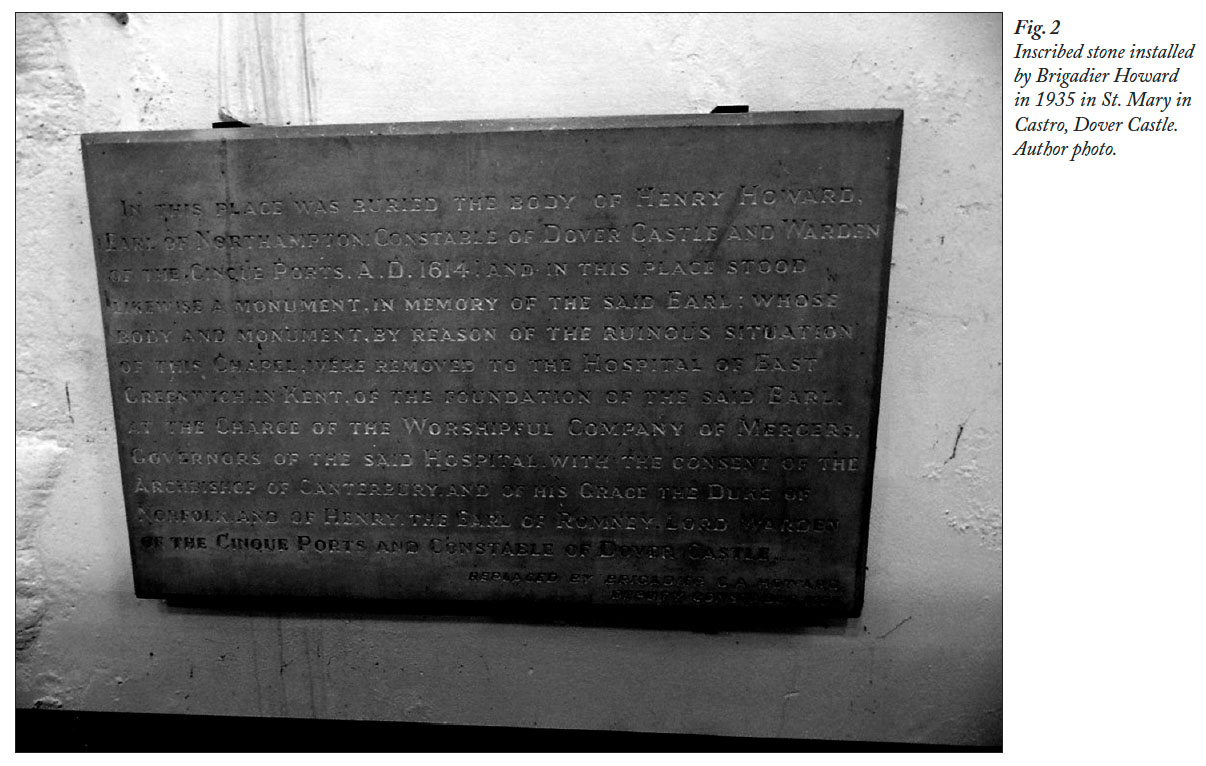 Display large image of Figure 2
Display large image of Figure 220 The body and tomb were removed to the Trinity Hospital Chapel and the memorial stones explaining the removal were installed in both places. The Dover church continued its slow dis- integration, and in 1787 the anonymous author of A Brief history of Dover-Castle wrote that the inscription stone explaining the circumstance of Northampton’s removal, which he had noted in the wall of the chapel just a few years earlier, was then “wantonly broken, and the remains [were] buried in the rubbish” (Anon. 1787: 23). Those remains appear to have disappeared entirely: William Batcheller’s New history of Dover & Dover Castle during the Roman, Saxon, and Norman Governments, published in 1828, stated that the tablet that had recorded the movement of the tomb and the body to Greenwich “[wa]s now demolished” (Batcheller 1828: 24), and by 1851 the church was being used as a coal storage depot for the garrison (Anon. 1851: 56). The current verger, Thomas Russell, speculates that the pieces of the tablet may have been in the nine feet of earth and rubbish that John Puckle in his book on Dover Castle says was excavated from the church when they cleared it down to its original floor level before its reconstruction in 1860 (Puckle 1864: 128). An inscribed stone bearing wording very similar to that which the Brief History asserts was on the original stone was installed in the rebuilt church in 1935, by Brigadier C. A. Howard, then Deputy Constable of the Castle, and it remains there today (Fig. 2).
21 After his removal to Greenwich, the Earl rested in relative peace for more than a century. In May 1780, one of Horace Walpole’s cor- respondents, Nathaniel Hillier, a member of the Mercers’ Company who made yearly visitations to Trinity Hospital, described the tomb in a letter to Walpole, stating it was “the identical one which was in the chapel” at Dover, and he gave the history of its removal (Lewis and Wallace 1975 [1951]: 86). The details of his description of the monument largely match the early 17th-century drawings, and the dimensions he gives for it are very close to those dictated in the original con- tract. It appears that it did make the journey from Dover intact and was properly reconstructed, though by the time Hillier saw it, some of the elements may have been reworked to some extent. A notation in the Trinity Hospital vouchers for the period 1762-1764 list payments to a mason for “work done at the Earl of Northamtons [sic] College or Hospital ... 3 new Portland molded Pedestals Painted Black Set under the Statues to the Monument” (MCA 1/118, Trinity Hospital Vouchers).
22 The work at the hospital took two weeks, and included repairs to the statues themselves, judging by notations of payments for “Cleaning and Puting Pices to the Statues” and “Cleaning, piceing, Painting Taking down the Statues Repair and Seting the same,” as well as the purchase of 29 pounds of “Plaster of Parris” and “A Pice of black marble” (MCA 1/118, Trinity Hospital Vouchers). The statues now certainly evince signs of both damage and repair or reconstruction in areas such as the faces and hands (Fig. 3). Whether or not the new pedestals attempted to imitate the original forms is not conveyed by the records, and the statues currently do not appear to be set on pedestals of the description mentioned in the contract or shown on the drawings of the original structure (Fig. 4). Further work was done on other parts of the monument. In May 1778, a bill to a different mason included charges for “Cleaning the Monument in Chappell & Mending the Figure”; “Letters New Gold Siz’d & Gilt”; and “Gilding the Cot of Arms and Prickining in Colours; & Gilding Ornaments Round Effigy” (MCA 1/118, Trinity Hospital Vouchers). A receipt from May 1779 is for “Iron Rayles Round the Monument in the Chappell . Twis Painted . Blew . 12 Yards & 8. Yard” (MCA 1/118, Trinity Hospital Vouchers).
 Display large image of Figure 3
Display large image of Figure 3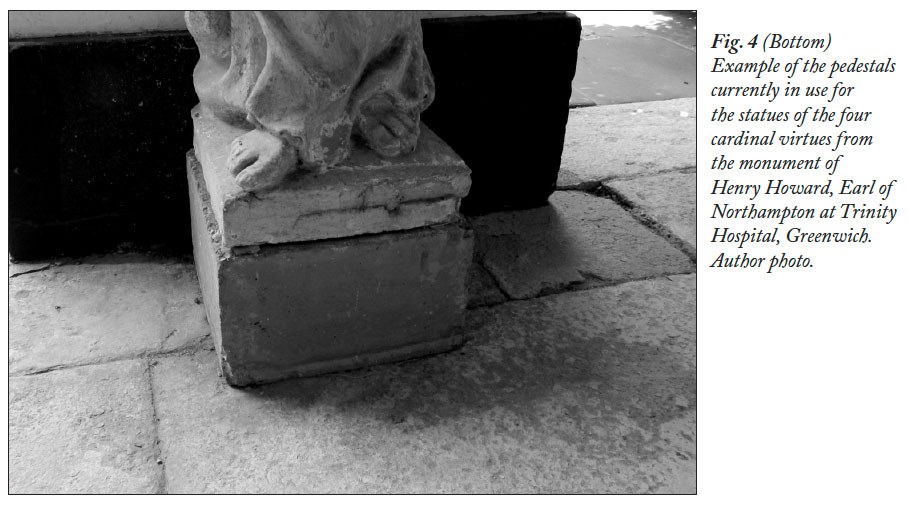 Display large image of Figure 4
Display large image of Figure 423 But despite the care taken in maintaining and repairing the monument in its new home, it fell victim eventually to a different peril. The Trinity Hospital vouchers for 1810 include various receipts and terms of agreement for “Building a New Chapel at Trinity Hospital.” The carpenter’s contract dated May 1810 lists the expected and quite extensive works: taking off the Chapel roof, and reframing for a new one, adding wainscoting around the Chapel, remov- ing the old pews and building new ones “with Partitions Seats and Book boards, also Reading and Clerke Desks,” putting down a new floor for the Communion table, fixing window frames, and creating a new door casing “and Gothic folding Doors with suitable Dressings” (MCA 1/119, Trinity Hospital Vouchers). Also in May, a receipt was submitted for carpenters’ work in “preparing Casing and enclosing Marble Work in Chapel and the Duke of Norfolks Coffin &c,”2 presumably to protect the monument while the building was being picked to bits around it (MCA 1/119, Trinity Hospital Vouchers).
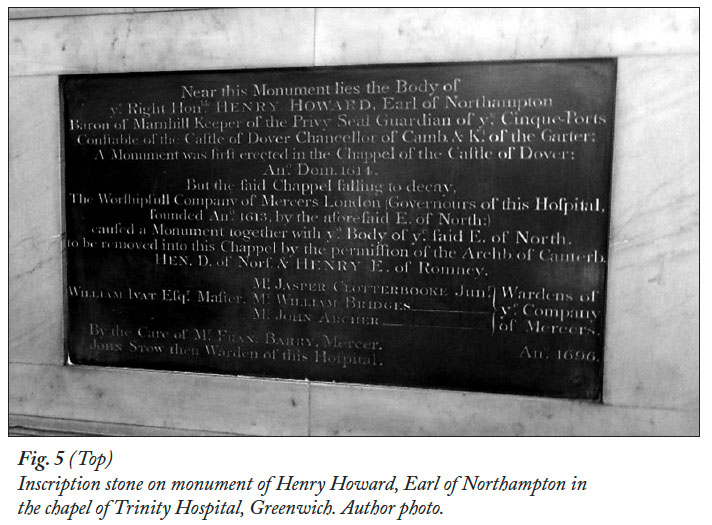 Display large image of Figure 5
Display large image of Figure 5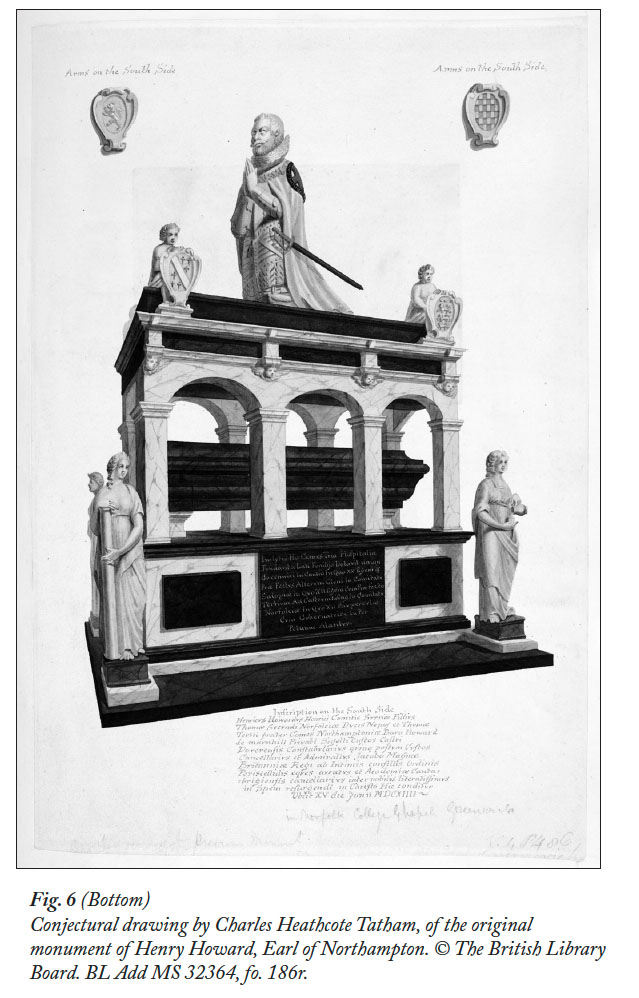 Display large image of Figure 6
Display large image of Figure 624 The Acts of Court books have no references to what may have befallen the monument during this major rebuilding, detailing mainly, in 1810, instructions for facilitating the necessary sale of bonds to provide sufficient sums of money to finance the expenses of rebuilding the Chapel. The only other hint of specific work done to the monument in that period is a bill for masons’ work at Trinity Hospital over the years 1810 and 1811, which includes Portland plinths. In addition, below the original summation of the total for the work done on the chapel at large, there is a notation in different coloured ink of “Masons work to Monument as pr Estimate £50” (MCA 1/119, Trinity Hospital Vouchers). A bill of 1812 also has a notation of painting a coat of arms, but provides no further detail (MCA 1/119, Trinity Hospital Vouchers).
25 Whether these were attempts to repair the tomb after the extensive building work was done is uncertain, but several sources indicate that dur- ing the rebuilding of the chapel the monument was damaged to such an extent that it could not be put back together. Lyon hints at some of the damage that occurred, in his comments that when the Trinity chapel was rebuilt the Latin inscription on the tomb was still legible, but he remarks that during the construction the masons, with no one overseeing their work, “defaced the inscription and removed the sculptured stone” and that nothing remained but “the bust of the Earl” and the inscribed stone on the Earl’s tomb which related the reasons for its removal from Dover (Fig. 5; Lyon 1813-1814: 45). Lyon did not appear to know of the other pieces which survived and were not reincorporated with the present structure: three of the four “little boys” once seated on the four corners of the cornice who held the escutcheons of arms, the four virtues, and a coat of arms from one end of the tomb.
26 Charles Heathcote Tatham, Warden of Trinity Hospital from 1837-1842, incorporated all of those remaining pieces into his conjectural drawing of the tomb in 1838 (Fig. 6). A pamphlet on the tomb published by Tatham in 1838 and reprinted in 1873 states that the only portion of the original monument to survive “in a perfect state” (4) was the Earl’s effigy, contrary to Lyon’s belief that the inscription stone detailing the removal had survived, and a volume in the British library, which contains a drawing of an inscription stone that resembles the present one, but on which the inscription differs, suggests the original stone was indeed completely replaced (BL Add MS 27401: fo. 185v). Tatham further says that in his time all four of the putti were still in existence, as well as a tablet with a Latin inscription, which is no longer in evidence (1873 [1838]: 5-6).
27 Tatham, an architect and designer who also seems to have entered with enthusiasm into recording and organizing the history of the hospital and its founder, bent his energies to the renovation of the hospital, as well as apparently to the restoration of some of its earlier character. He installed stained glass in place of the plain glass in some of the chapel windows, ordered “a coronet from an ancient Pattern for the Founders Statue in the Chapel” (MCA 1839-40, Trinity Hospital Vouchers), and purchased a copy of Northampton’s Defensative on Prophecies for the Trinity Hospital library, to which he added such items as engravings of Northampton or Northumberland House and the Surrey tomb at Framlingham as well as an engraving done after his conjectural drawing of the Northampton tomb, which appeared in the aforementioned pamphlet (MCA 1838-39, Trinity Hospital Vouchers).
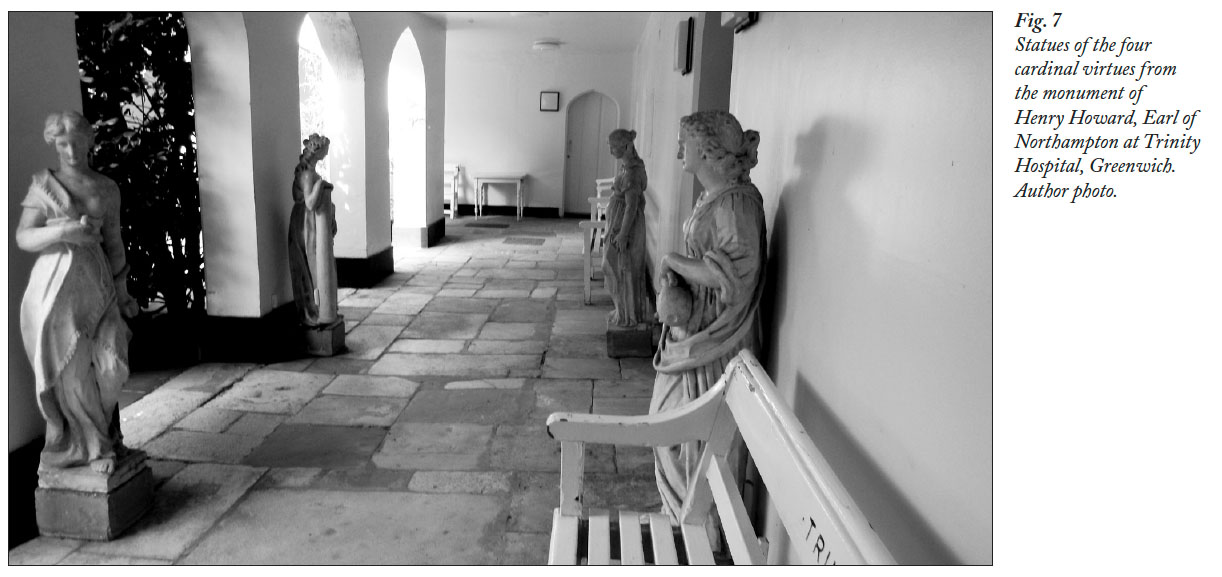 Display large image of Figure 7
Display large image of Figure 728 The remaining fragments of the monument were dispersed and moved around the grounds of Trinity over the next century, with the exception of the Earl’s effigy and one other black tablet from the original tomb, with the inscription “Iohanne Griffitho huic Comiti ab epistolis curante Positum” (Erected by the care of John Griffith secretary to this Earl), which is on the current monument. C. A. Bradford in The Lewisham Antiquarian Society Proceedings for 1898-1899 commented on “the remains of the sculptured figures now scattered in the garden of the Hospital” and identified them as the four virtues (Bradford 1899: 13). Katherine Esdaile, an historian of British sculpture, said that in 1886 the four Virtues stood in the garden, painted bronze, the seated putti were in a rockery, and two of the four shields of arms that they had held were over the entrance gate and on the Warden’s staircase (1935: 225). The canopy and sarcopha- gus appear to have completely disappeared as well as the pillars and the pedestals for the virtues.
29 At the present time, the elements mentioned above by Esdaile have undergone further changes; if the statues were indeed painted bronze, that has worn away or been removed, and they currently stand outside the door of the chapel (Fig 7). Three of the seated putti holding the coats of arms remain, but, sadly, are damaged. The coat of arms on the Warden’s staircase is not one of those that were held by the putti; Tatham identifies it as part of the monument (1873 [1838]: 5). To judge by its size, shape and colouration, and in comparing it with the contract details and one of the drawings made from the tomb in situ at Dover, (Fig. 8) it seems to be one from the end of the Earl’s tomb, and perhaps is the one mentioned above being re-gilded in 1778, or repainted in 1812 (Fig.9). The Earl, in his stately pose, and the black tablet just below the effigy with the inscription to John Griffith (Fig. 10), are all that have survived the journey over four centuries in reasonably good shape. As a case study of the afterlife, or lingering death, of a piece of monumental sculpture, Northampton’s tomb is an intriguing one.
 Display large image of Figure 8
Display large image of Figure 8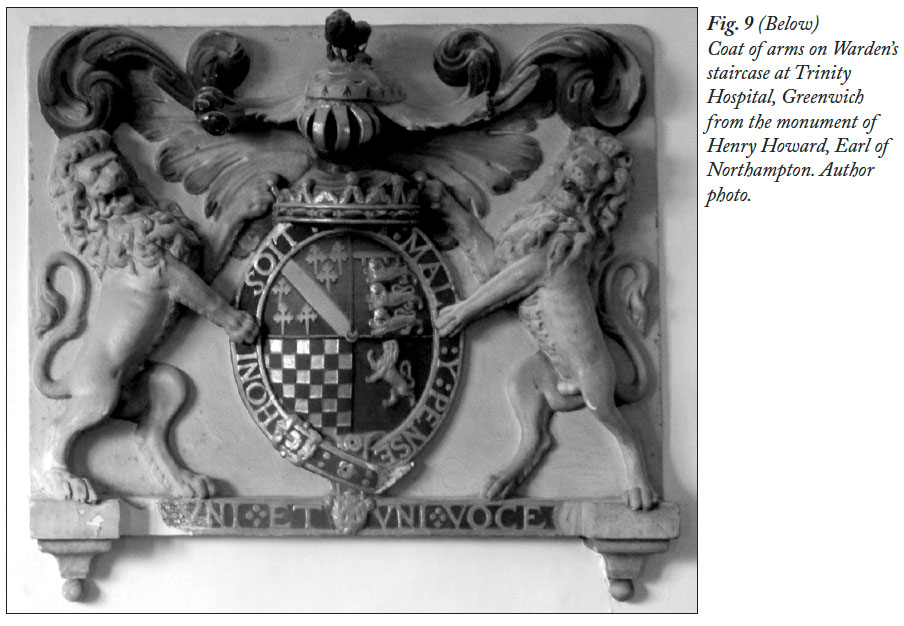 Display large image of Figure 9
Display large image of Figure 930 Along with the other remnants of fading glory, the hospital’s title itself shifted over the centuries to a common usage that denied Northampton the primary credit as founder, as it became readily identified in both publica- tions and colloquial use as Norfolk College, or the Duke of Norfolk’s College, as often as it was called Trinity Hospital or Northampton’s College. Bradford’s essay on the hospital in 1899 refers to it throughout as Norfolk College, despite his lengthy biography of Northampton and the story of his laying the foundation stone of the chapel (Bradford 1899: 12). In this perhaps he is following his sources, which variously refer to Trinity as “Norfolk Hospital,” “The Duke of Norfolk’s Almshouses,” and “Norfolk College” (Bradford 1899: 12). That it was familiarly referred to in this fashion seems evident from the tradesmen’s bills in the Mercers’ Company archive from the 1760s which in some cases call it “the Earl of Northamtons College or Hospital” or “Trinnity Colledge” but also “His Grace the Duke of Norfolks College” and “Norfolk Colage” as well as containing the aforementioned nota- tion from the carpenter’s bill for encasing “the Duke of Norfolks Coffin,” which could only be a reference to the Earl’s tomb, there being no other member of the Norfolk family buried at Trinity. This practice continued into the next century, with several bills and receipts for 1810 and 1811 being addressed to Norfolk College by the linen drapers, the haberdashers, the coal suppliers, and even the collectors of the window tax (MCA 1/119, Trinity Hospital Vouchers). Even a letter among those receipts was addressed and posted to “Norfolk College” so it appears that it was sufficiently well known by that designation for the post to find its way there (MCA 1/119, Trinity Hospital Vouchers).
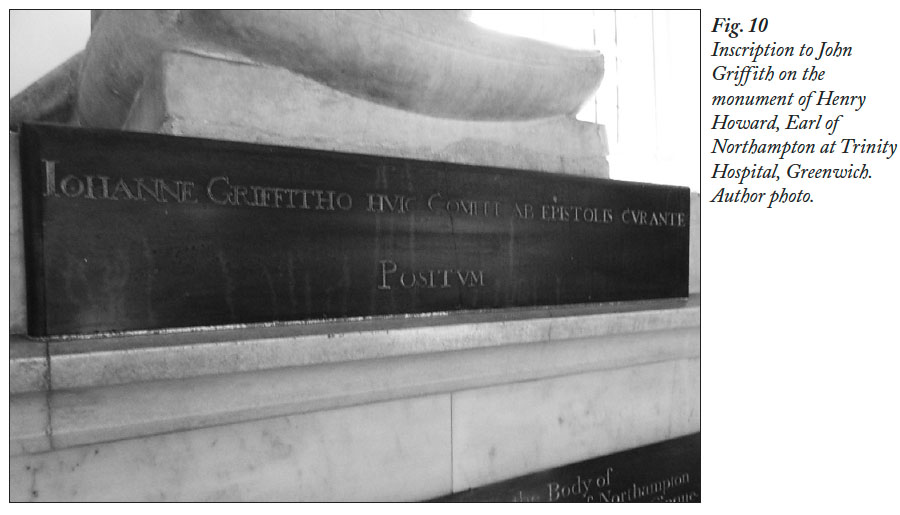 Display large image of Figure 10
Display large image of Figure 1031 The story of Northampton’s tomb can be summarized in a comment made by an onlooker to the Earl’s final passage from Greenwich to his home in the Strand before his death, with his numerous retinue: “sic transit gloria mundi” (McClure 1939, 1: 539; Thus passes the glory of the world). Having climbed rapidly from an impoverished son of the nobility to a pre-eminent courtier of James I, Northampton bent his efforts to the task of solidifying his fame and that of his family and achieved this partly through the creation of memorials, his own and his father’s, and his charitable foundations. Nestled in the safe confines of Dover Castle, his tomb appeared to be sited in a secure place, with a hired keeper to ensure its maintenance, yet within a century, the grand and impressive monument made a journey of twice as many miles as that of his grandfather’s from Thetford to Framlingham to reach what then seemed to be its final resting place. A little over a century later, it was once again dismantled, this time permanently. The noble monument by which Northampton marked the restoration of the grandeur of his house was felled in the end not by the religious upheaval that had displaced his family’s first mausoleum, nor by iconoclasm, but by the accidents of time and change, simple neglect, and the carelessness of 19th-century workmen. Two hundred years after his death, the image so hopefully constructed by the Earl, and which he intended to present to the world for all eternity, was reduced to a humbler state, and his offering to fame was once more vanquished by fortune.